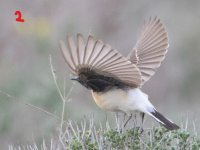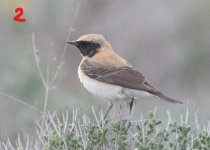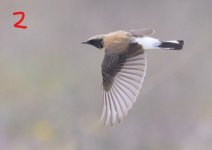I am unsure if I have the necessary experience you ask for, but I will start the ball rolling.
No doubt this is an interesting bird and I understand your request for help. In some ways it has an apparently restricted black mask (above the eye) and upperpart hues more typical of Western Black-eared, but in others more indicative of Eastern - extent of black on neck sides, plus slight grey-brown hue on crown and scapulars. It also opens an interesting debate as the whether some birds in Greece are a mix of both.
There are a handful of images of 2cy males on eBird from Greece of EBeW in which the sandy-ochre colour is similar to that of WBeW and which show a variability in mask shape and extent. Typical adult males have a lot of black on the the face - above bill/eye and extending back beyond ear coverts and lower onto throat; 2cy males are more likely to have less black visible as it is hidden by pale fringes to these feathers.
ML438871011 Eastern Black-eared Wheatear Macaulay Library - narrow mask
ML327991191 Eastern Black-eared Wheatear Macaulay Library - similar but a little more typical
ML341967881 Eastern Black-eared Wheatear Macaulay Library - a 2cy male similar to yours
However, I feel that the upperpart colour of the above birds differs subtly from WBeW which has a slightly brighter orange-ginger hue; also, the extension of black onto the neck side shown by yours is odd for WBeW.
eBird WBeW from Spain
ML327518221 Western Black-eared Wheatear Macaulay Library
ML152971811 Western Black-eared Wheatear Macaulay Library - bright 2cy male
If we accept that all birds from Greece are EBeW then your fits in with that variability.
Brian













